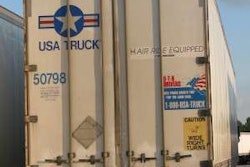|
Getting a handle on tire maintenance and extending tire life is crucial for any fleet, regardless of economic conditions. Keeping track of individual tires can be a headache for even the most organized fleet manager. But money saved by maximizing tire life goes straight to the bottom line, highlighting the dramatic impact a good maintenance program can have on a fleet’s overall financial health. But consider the challenge faced by Ryder System, which has a fleet of 160,000 vehicles and purchases about 300,000 new tires every year. According to Scott Perry, group director of vehicle supply management at Ryder’s Miami-based headquarters, a comprehensive tire management system is vital for controlling costs and assuring customer satisfaction. “I don’t know that we can – or would – attempt to quantify this program in dollars,” Perry says. “But I can tell you that in the 15 to 17 years we’ve had defined, total tire management discipline, we’ve seen our vehicle breakdowns related to tire failures go down exponentially.”
At the same time, Ryder has seen the yield of its tires – their absolute life – improve through both management practices and air pressure management competencies. “That’s in conjunction with improvements being made by our Bridgestone/Firestone and Bandag partners in compounding and tread design, as well as the selection of what treads we use in what applications,” Perry says. Good tire maintenance practices should be part of any fleet’s culture, regardless of size. And technology has advanced in recent years to provide many resources to help with tire management. Pressure monitoring and inflation systems, computer software programs and more can make tracking, maintaining and analyzing tires easier. However, just because a fleet might not be able to afford the technology – or perhaps not even understand how to use it – doesn’t excuse it from having some kind of tire program. “Despite today’s technology, a fleet’s tire management system can still be old-fashioned and done with pencil, paper and a tire gauge,” says Doug Jones, customer engineering support manager for Michelin Americas Truck Tires. A solid tire maintenance program calls for cradle-to-grave tracking, strong preventive maintenance and savvy analysis. Perhaps most of all, fleets should put their tire maintenance programs in writing, ensure everyone knows them and revisit their programs often. Dealing with dealers Active OEM/dealer participation is crucial for an operation the size of Ryder System. From an inventory-planning standpoint, making sure the company has the proper tires on hand at the right time for the proper truck is critical. “We have a tire matrix, developed with our partners, established for each location to help them understand the fleet mix because it is so broad and diverse, ranging from light-duty up through medium- and heavy-duty vehicles – trucks, tractors and trailers,” Perry says. The matrix permeates through every aspect of Ryder’s tire maintenance program, from the decisions regarding what inventory needs to be on hand, down to keeping the company’s retread partners focused on producing tires to support upcoming demand and managing casing inventory as used tries flow back through the retread network. “Those are all very critical pieces of the operation,” Perry says. There is no shortage of dealers eager to sell tires to a fleet, but simply selling tires isn’t good enough anymore, says Steve Powers, vice president of sales for Brahler’s Truckers Supply, a Peoria, Ill.-based independent tire dealer. Powers’ advice to fleets is to seek out a dealer who will be their business partner and supply them with tire maintenance solutions as well as products. “We have fleets that we check every day to see what their needs are,” Powers says. “It gives us as a dealer the opportunity to cut a fleet’s road expenses and actually increases our income in the long run, because if we miss a flat tire or a tire that needs to be replaced and the truck goes out on the road and has the work done, it costs the fleet four times more than it should, in addition to downtime and everything else. But the dealer also has lost that sale, and then the poor fleet’s got a mismatched tire out there and the problem completely compounds itself. There are many benefits to being a partner with the fleets we serve.” One example is a fleet’s casing flow program. Brahler’s analyzes scrap tires for its fleet customers and tracks and records unit numbers. “We can tell our fleet partners, ‘You lost six tires a week because they were brake-skidded, and this is how much money you lost and where, and these are the units the tires came off of,’ ” Powers says. In contrast, many dealers simply use scrap tire analysis to undercut their competition. “They’ll tell you the other guy’s tire failed because it’s no good,” Powers says. “But the fleet often never finds out why that tire failed.” A few years ago, Powers had a fleet customer in Chicago that was getting huge gouges in drive and steer tires with 80 percent of their tread life left on them. The fleet felt there was something wrong with the tires it was buying. But Powers suspected the damage was indicative of crossmembers tearing chunks out of the tires because the driver was in a bind and was backing or turning the rig to get out of a tight situation. “It got to the point where the fleet was turning back in five or six of these tires a week, and costing them about $20,000 a year,” he says. To make matters worse, the fleet wasn’t tracking unit numbers, so there was no way to correlate the tire damage with specific vehicles and uncover the cause of the problem. After researching the problem, Brahler’s learned the fleet had low-profile fifth wheels and the trailers were sitting too low in conjunction with the tractor. They reported their findings to their customer, who changed the offending fifth wheels out and solved the problem. Under pressure A tire pressure program includes targeted pressures for the tires, periodic checks of air pressure, calibrated air pressure gauges, a master gauge and trained employees willing to check the pressures diligently. Following the instructions on the truck’s data plate also is key to ensuring that tires have the correct air pressure for the loads being carried. Air pressure is so important, Jones maintains, that if a fleet has nothing else but a good air pressure maintenance program, it will reap substantial benefits over having no program at all. Ryder’s aggressive air pressure maintenance program includes an air pressure check every time one of its vehicles arrives at a service island or a maintenance facility and undergoes preventive maintenance or specific brake or tire work. “We try to touch that vehicle as many times as possible whenever it is in our control to verify proper tire inflation,” Perry says. “We also recognize when there are variances outside of specs and take appropriate action.” Ryder also has strict standards for the mounting of its tires, which are delivered by the fleet’s partners fully assembled and installed at its own maintenance facilities. “We make sure to follow the proper installation protocol to ensure a good bead seat, and that will allow us to recognize the full yield and performance of the tire from a drive or rideability standpoint,” Perry says. Doing so eliminates many of the steering movements that drivers often will report in a write-up, giving them a safer truck to operate and a satisfied lease or rental experience with Ryder. That’s a sentiment shared heartily by James Mason, maintenance director for McConnell Truck in Little Rock, Ark. Mason’s fleet of tractors and bulk tank trailers – which haul sand, cement and roofing granules throughout Arkansas, Texas, Oklahoma and Western Tennessee – isn’t nearly as large as Ryder’s, but he still considers air pressure the single most important aspect of extending tire life and moves quickly if a tire is found to be more than 10 pounds low upon inspection. “We pull the trailer over to the tire bay and either jack it up or check it on the trailer for leaks and repair it,” Mason says. “Simply adding air to a low tire isn’t solving the problem and will probably lead to a blowout or a greater problem on down the road.” Going the extra mile McConnell ended up trying Goodyear DuraSeal tires on one of its trucks. The driver went from a 100-percent tire loss over a five-month period to getting almost 30,000 miles per 32nd of tread wear. “Those tires are going to run about 240,000 miles, and we’re still going to have a good casing to cap when they’re done,” he says. “So, given our application, this was the right call for us.” Mike Dickens, president of Hammell Transport Service Inc. in Hermiston, Ore., faced a similar challenge when he switched his fleet over from conventional tires to wide-base drive and trailer tires. Hammell is a refrigerated carrier hauling foodstuffs up and down the West Coast, and like many carriers going in and out of California, Dickens was looking to land a U.S. Environmental Protection Agency SmartWay certification for the fleet. Although fuel economy was his prime motive for switching to wide-base tires, Dickens also was concerned about the possibility of catastrophic tire failure with the new tires. “Loss of air is the cause of 99 percent of tire failures, in my experience,” he says. “But with conventional tires, a truck can limp along for help after a blowout. If a super-single goes, you’re going to lose the tire, the wheel and be stuck on the side of the road – and that’s a best-case scenario.” To combat the possibility of low tire pressures and blowouts, Dickens put real-time tire pressure management systems – the TireStat system from Mobile Awareness – on both his tractors and trailers. “It’s worked very well for us so far,” Dickens says. “We’ve had several instances where drivers were alerted to punctures in their tires, and we were able to avoid blowouts and associated damage costs and downtime.” Keeping track of tires may seem daunting, but the good news, as Perry notes, is that many of the principles Ryder follows can be scaled down to a three-, 300- or 3,000-truck operation. Even better news is that the most basic tire maintenance plan that emphasizes proper inflation pressures can yield immediate positive results in terms of cost savings and downtime. |









